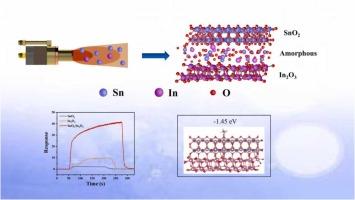基于SnO2/In2O3异质结的结构调制提高室温下乙醇敏感性
IF 8
1区 化学
Q1 CHEMISTRY, ANALYTICAL
引用次数: 0
摘要
开发用于实时监测乙醇气体浓度变化的半导体传感器是环境治理和人类健康保护的重要要求。本文采用新型等离子体熔合方法制备了独特的SnO2/非晶/In2O3三元异质结构,该异质结构在乙醇检测中具有优异的性能。其响应值(41)是纯SnO2和In2O3的数倍甚至数十倍,响应/恢复时间短,表明气敏反应动力学快,同时具有超高的选择性和抗干扰能力。现场试验和第一性原理密度泛函理论(DFT)计算证明,其独特的非均质结构是其性能的关键。高结晶度的SnO2和非晶态的SnO2分别对乙醇和氧分子具有良好的吸附效果。因此,界面成为气敏反应的最佳场所。我们制备的纳米材料的小尺寸增加了相边界的数量,为优异的性能提供了进一步的保证。结果表明,这是一种很有前途的结构材料。本文章由计算机程序翻译,如有差异,请以英文原文为准。

Structure modulation based on SnO2/In2O3 heterojunction to improve ethanol sensitivity at room temperature
The development of semiconductor sensors for real-time monitoring of ethanol gas concentration changes is an important requirement for environmental governance and human health protection. In this paper, a new type of plasma fusion method is used to prepare a unique SnO2/amorphous/In2O3 ternary heterostructure, which has excellent performance in ethanol detection. Its response value (41) is several or even tens of times higher than that of pure SnO2 and In2O3, and its short response/recovery time indicates fast gas-sensitive reaction kinetics, while at the same time, having ultra-high selectivity and anti-interference capability. In-situ tests and First-principles density functional theory (DFT) calculations prove that its unique heterogeneous structure is the key to its performance. The highly crystalline SnO2 and amorphous structures have good adsorption effects on ethanol and oxygen molecules, respectively. Therefore, the interface becomes the best place for gas-sensitive reactions. The small size of the nanomaterials prepared by us increases the number of phase boundaries and provides further guarantee for excellent performance. All the results show that this is a promising structural material.
求助全文
通过发布文献求助,成功后即可免费获取论文全文。
去求助
来源期刊

Sensors and Actuators B: Chemical
工程技术-电化学
CiteScore
14.60
自引率
11.90%
发文量
1776
审稿时长
3.2 months
期刊介绍:
Sensors & Actuators, B: Chemical is an international journal focused on the research and development of chemical transducers. It covers chemical sensors and biosensors, chemical actuators, and analytical microsystems. The journal is interdisciplinary, aiming to publish original works showcasing substantial advancements beyond the current state of the art in these fields, with practical applicability to solving meaningful analytical problems. Review articles are accepted by invitation from an Editor of the journal.
 求助内容:
求助内容: 应助结果提醒方式:
应助结果提醒方式:


